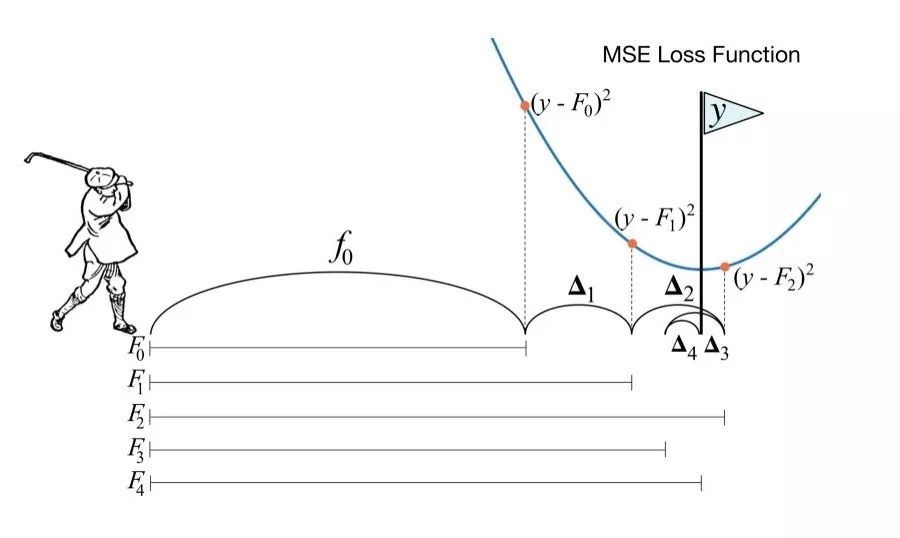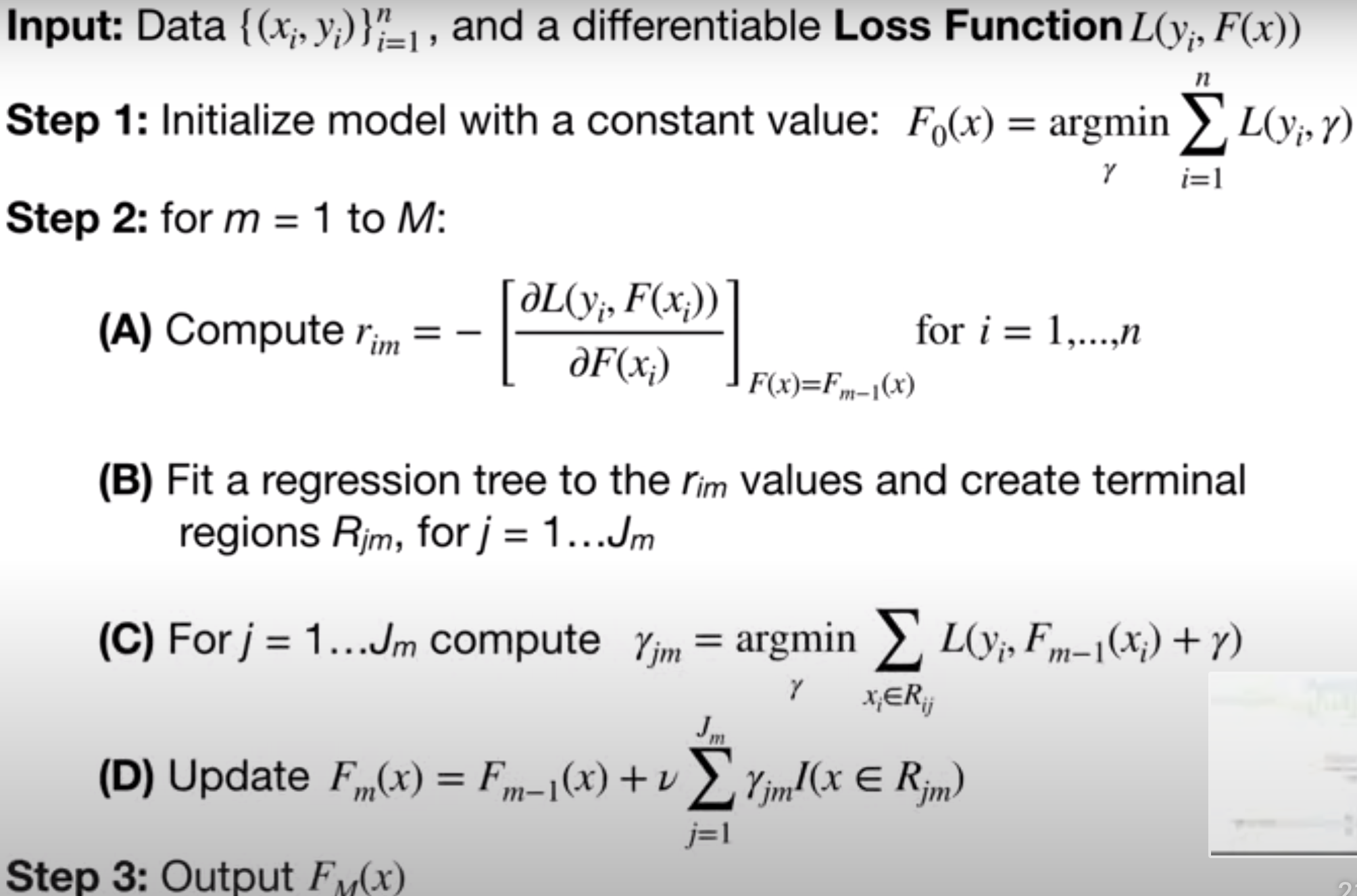一步步透視 GBDT Regression Tree
TL;DR
訓練完的 GBDT 是由多棵樹組成的 function set $f_1(x), …,f_{M}(x)$
- $F_M(x) = F_0(x) + \nu\sum^M_{i=1}f_i(x) $
訓練中的 GBDT,每棵新樹 $f_m(x)$ 都去擬合 target $y$ 與 $F_{m-1}(x)$ 的 $residual$,也就是 $\textit{gradient decent}$ 的方向
- $F_m(x) = F_{m-1}(x) + \nu f_m(x)$

結論說完了,想看數學原理請移駕 背後的數學,想看例子從無到有生出 GBDT 的請到 Algorithm - step by step ,想離開得請按上一頁。
GBDT 簡介
GBDT-regression tree 簡單來說,訓練時依序建立 trees $\{ f_1(x), f_2(x), …. , f_M(x)\}$,每顆 tree $f_m(x)$ 都站在 $m$ 步前已經建立好的 trees $f_1(x), …f_{m-1}(x)$ 的上做改進。
所以 GBDT - regression tree 的訓練是 sequentially ,無法以並行訓練加速。
我們把 GBDT-regression tree 訓練時第 $m$ 步的輸出定義為 $F_m(x)$,則其迭代公式如下:
- $\nu$ 為 learning rate
GBDT 訓練迭代的過程可以生動的比喻成 playing golf,揮這一杆 $F_m(x)$ 前都去看 “上一杆 $F_{m-1}(x)$ 跟 flag y 還差多遠” ,再揮杆。
差多遠即 residual 的概念:
因此可以很直觀的理解,GBDT 每建一顆新樹,都是基於上一步的 residual
GBDT Algorithm - step by step
Algorithm 參考了 statQuest 對 GBDT 的講解,連結放在 reference,必看!
GBDT-regression tree 擬合 algorithm:
 Input Data and Loss Function
Input Data and Loss Function
input Data $\{(x_i, y_i)\}^n_{i=1}$ and a differentiable Loss Function $L(y_i, F(x))$
Data

接下來都用這組簡單的數據,其中
- Target $y_i$ : weight which is what we want to predict
- $x_i$: features 的組成有 身高,喜歡的顏色,性別
目標是用 $x_i$ 的 height, favorite color, gender 來預測 $y_i$ 的 weight
loss function 為 square error
square error commonly use in Regression with Gradient Boost
$\textit{observed - predicted}$ is called $residual$
$y_i$ are observed value
$F(x)$: the function which give us the predicted value
也就是所有 regression tree set $(f_1, f_2, f_3, ….)$ 的整合輸出
Step 1 Initialize Model with a Constant Value
初始 GBDT 模型 $F_0(x)$ 直接把所有 Weight 值加起來取平均即可

取 weight 平均得到 $F_0(x) = 71.2 = \textit{average weight}$
Step 2
For $m=1$ to $M$,重複做以下的事
- (A) calculate residuals of $F_{m-1}(x)$
- (B) construct new regression tree $f_m(x)$
- (C) compute each leaf node’s output of new tree $f_m(x)$
- (D) update $F_m(x)$ with new tree $f_m(x)$
At epoch m=1
(A) Calculate Residuals of $F_{0}(x)$
epoch $m =1$,對每筆 data sample $x$ 計算與 $F_{0}(x)$ 的 residuals
而 $F_0(x) = \textit{average weight = 71.17}$
計算 residual 後:

- epoch_0_prediction 表 $F_0(x)$ 輸出
- epoch_1_residual 表 residual between observed weight and predicted weight $F_0(x)$
(B) Construct New Regression Tree $f_1(x)$
此階段要建立新樹擬合 (A) 算出的 residual
用 columns $\textit{height, favorite, color, gender}$ 預測 $residuals$ 來建新樹 $f_1(x)$

建樹的過程為一般的 regression tree building 過程,target 就是 residuals。
假設我們找到分支結構是

綠色部分為 leaf node,data sample $x$ 都被歸到 tree $f_1(x)$ 特定的 leaf node 下。

- epoch_1_leaf_index,表 data sample $x$ 歸屬的 leaf node index
(C) Compute Each Leaf Node’s Output of New Tree $f_1(x)$
此階段藥決定 new tree $f_1(x)$ 每個 leaf node 的輸出值
直覺地對每個 leaf node 內的 data sample $x$ weight 值取平均,得到輸出值


- epoch_1_leaf_output 表 data sample $x$ 在 tree $f_1(x)$ 中的輸出值
(D) Update $F_1(x)$ with New Tree $f_1(x)$
此階段要將新建的 tree $f_m(x)$ 合併到 $F_{m-1}(x)$ 迭代出 $F_m(x)$
現在 $m=1$,所以只有一顆 tree $f_1(x)$,所以 $F_1(x) = F_0(x) + \textit{learning rate } \times f_1(x)$
假設 $\textit{learning rate = 0.1}$ ,此時 $F_1(x)$ 對所有 data sample $x$ 的 weight 預測值如下

- epoch_1_prediction 表 data sample $x$ 在 $F_1(x)$ 的輸出,也就是擬合出的 weight 的值
At epoch m=2
(A) Calculate Residuals of $F_{1}(x)$
m = 2 新的 residual between observed weight and $F_1(x)$如下

- epoch_1_prediction 為 $F_1(x)$ 的輸出
- epoch_2_residual 為 observed weight 與 predicted weight $F_1(x)$ 的 residual
(B) Construct New Regression Tree $f_2(x)$
建一顆新樹擬合 epoch 2 (A) 得出的 residual

- epoch_2_residual 為 $f_2(x)$ 要擬合的 target
假設 $f_2(x)$ 擬合後樹結構長這樣


- epoch_2_leaf_index 表 data sample $x$ 在 tree $f_2(x)$ 對應的 leaf node index
(C) Compute Each Leaf Node’s Output of New Tree $f_2(x)$
決定 new tree $f_2(x)$ 每個 leaf node 的輸出值,對每個 leaf node 下的 data sample $x$ 取平均

- epoch_2_leaf_output 表 tree $f_2(x)$ 的輸出值。記住 , $f_2(x)$ 擬合的是 residual epoch_2_residual
(D) Update $F_2(x)$ with New Tree $f_2(x)$
到目前為止我們建立了兩顆 $tree$ $f_1(x), f_2(x)$,假設 $\textit{learning rate = 0.1}$,則 $F_2(x)$ 為
每個 data sample 在 $F_2(x)$ 的 predict 值如下圖:

- weight: out target value
- epoch_0_prediction $F_0(x)$ 對每個 data sample $x$ 的輸出值
- epoch_1_leaf_output: $f_1(x)$ epoch 1 的 tree 擬合出的 residual
- epoch_2_leaf_output: $f_2(x)$ epoch 2 的 tree 擬合出的 residual
- epoch_2_prediction: $F_2(x)$ epoch 2 GDBT-regression tree 的整體輸出
Step 3 Output GBDT fitted model
Output GBDT fitted model $F_M(x)$
Step 3 輸出模型 $F_M(x)$,把 $\textit{epoch 1 to M}$ 建的 tree $f_1(x),f_2(x), …..f_M(x)$ 整合起來就是 $F_M(x)$

$F_M(x)$ 中的每棵樹 $f_m(x)$ 都去擬合 observed target $y$ 與上一步 predicted value $\hat{y}$ $F_{m-1}(x)$ 的 $residual$
GBDT Regression 背後的數學
Q: Loss function 為什麼用 mean square error ?
選擇 $\cfrac{1}{2}(\textit{observed - predicted}) ^2$ 當作 loss function 的好處是對 $F(X)$ 微分的形式簡潔
其意義就是找出一個 可以最小化 loss function 的 predicted value $F(X)$, 其值正好就是 $\textit{negative residual}$
$-(y_i - F(X)) = \textit{-(observed - predicted) = negative residual } $
而我們知道 $F(X)$ 在 loss function $L(y_i, F(X))$ 的 gradient 就是 $\textit{negative residual}$ 後,那麼梯度下降的方向即 $residual$
Q:為什麼初始 $F_0(X)$ 直接對 targets 取平均?
我們要找的是能使 cost function $\sum^n_{i=1}L(y_i, \gamma)$ 最小的那個輸出值 $\gamma$ 做為 $F_0(X)$。
$F_0(x) = argmin_r \sum^n_{i=1} L(y_i,\gamma)$
$F_0(x)$ 初始化的 function,其值是常數
$\gamma$ refers to the predicted values
$n$ 是 data sample 數
Proof:
已知
所以 cost function 對 $\gamma $ 微分後,是所有 sample data 跟 $\gamma$ 的 negative residual 和 為 0
移項得到 $\gamma$
正是所有 target value 的 mean,故得證
Q:為什麼可以直接計算 residual,他跟 loss function 甚麼關係?
在 $m$ 步的一開始還沒建 新 tree $f_m(x)$ 時,整體的輸出是 $F_{m-1}(x)$,此時的 cost function 是
我們接下來想建一顆新 tree $f_m(x)$ 使得 $F_m(x) = F_{m-1}(x) + \nu f_m(x)$ 的 cost function $\sum^n_{i=1} L(y_i,F_{m}(x_i))$ 進一步變小要怎麼做?
觀察 $F_m(x) = F_{m-1}(x) + \nu f_m(x)$,是不是很像 gradient decent update 的公式
讓 $f_m(x)$ 的方向與 gradient decent 方向一致,對應一下,新的 tree $f_m(x)$ 即是
新建的 tree $f_m(x)$ 要擬合的就是 gradient decent 的方向和值, 也就是 residual
$f_m(x)$ = $\textit{gradient decent}$ = $\textit{negative gradient}$ = $residual$
GBDT 每輪迭代就是新建一顆新 tree $f(x)$ 去擬合 $\textit{gradient decent}$ 的方向得到新的 $F(x)$
這也正是為什麼叫做 gradient boost 。
by the way,step 2-(A) compute residuals:
- $i$: sample number
- $m$: the tree we are trying to build
Q:個別 leaf node 的輸出為什麼是取平均 ?
在 new tree $f_m(x)$ 結構確定後,目標是在每個 leaf node $j$ 找一個 $\gamma$ 使 cost function 最小
$\gamma_{j,m} = argmin_\gamma \sum_{x_i \in R_{j,m}} L(y_i, F_{m-1}(x_i) + \gamma)$
- $\gamma_{j,m}$ $m$ 步 第 $j$ 個 leaf node 的輸出值
- $R_{jm}$ 表 $m$ 步 第 $j$ 個 leaf node,包含的 data sample 集合
- $F_m(x_i) = F_{m-1}(x_i) + f_m(x_i)$, $x_i$ 在 $f_m(x)$ 的 leaf node $j$ 上的輸出值為 $\gamma_{j,m}$
直接對 $\gamma$ 微分
移項
- $n_{jm}$ is the number of data sample in leaf node $j$ at step $m$
白話說就是,第 $m$ 步 第 $j$ 個 node 輸出 $\gamma_{jm}$ 為 node $j$ 下所有 data sample 的 residuals 的平均
事實上跟一開始 $F_0(x)$ 取平均的性質是一樣的,$F_0(x)$ 一棵樹 $f(x) $ 都還沒建,可以視為所有 data sample 都在同一個 leaf node 下。
Q: 如何整合 tree set $f_1(t), f_2(t),……f_m(t)$ ?
- $F_{m-1}(x) = \nu\sum^{m-1}_{i=1} f_i(x)$
- $\nu$ learning rate
- $J_m$ m 步 的 leaf node 總數
- $\gamma_{jm}$ m 步 第 $j$ 個 node 的輸出
$F_m(x)$ 展開來就是
寫在最後
seeing is believing
太多次看了又忘的經驗表明,我們多數只是當下理解了,過了幾天、 幾個禮拜後又會一片白紙
人會遺忘,尤其是短期記憶,只有一遍遍不斷主動回顧,才能將知識變成長期記憶
learning by doing it
所以下次忘記時,不妨從這些簡單的 data sample 開始,跟著 algorithm 實作一遍,相信會更清楚理解的
1 | import pandas as pd |
always get your hands dirty
Reference
Main
ccd comment: 上面兩個必看
- A Step by Step Gradient Boosting Decision Tree Example https://sefiks.com/2018/10/04/a-step-by-step-gradient-boosting-decision-tree-example/
- 真 step by step
- Gradient Boosting Decision Tree Algorithm Explained https://towardsdatascience.com/machine-learning-part-18-boosting-algorithms-gradient-boosting-in-python-ef5ae6965be4
- including sklearn 實作
Other
- Gradient Boosting Decision Tree http://gitlinux.net/2019-06-11-gbdt-gradient-boosting-decision-tree/#1-gbdt-回归算法
- 提升树算法理论详解 https://hexinlin.top/2020/03/01/GBDT/
- 梯度提升树(GBDT)原理小结 https://www.cnblogs.com/pinard/p/6140514.html
一步步透視 GBDT Regression Tree
https://seed9d.github.io/GBDT-Rregression-Tree-Step-by-Step/